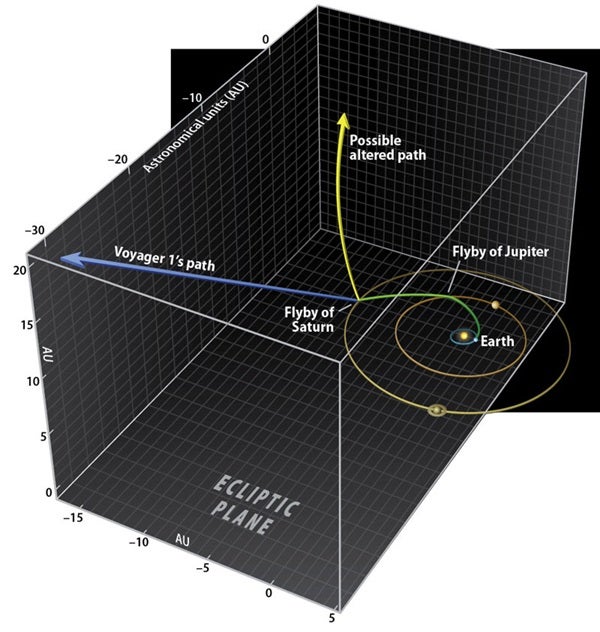Voyager 1 launched September 5, 1977, on a direct 546-day trajectory between Earth and Jupiter. The Jupiter flyby placed the craft on a 618-day path to Saturn, and the Saturn flyby threw the craft out of the ecliptic plane on an escape trajectory. More than 12 years after launch, with the craft 40 astronomical units (AU, where 1 AU is the average Sun-Earth distance) from the Sun, engineers pointed Voyager 1’s camera system back at the solar system. From a position 22 AU above the ecliptic plane, the craft recorded some impressive images, including the famous “pale blue dot” photo of Earth. Voyager 1’s Saturn encounter could have been modified such that the final Voyager orbit would have passed over the poles of the Sun with an orbital period of 181 years.
A typical planetary camera captures a 4° or 5° field. To get the entire solar system in one field of view would mean the craft would have to be 90° to the ecliptic plane with a 75° field of view; this would take 31 years after its Saturn encounter (provided it follows a modified Voyager 1 trajectory). At the point when the craft is 90° to the plane, it would be 38.4 AU above it. — John D. Anderson, NASA’s Jet Propulsion Laboratory (retired), Pasadena, California
Would it be possible to send a probe vertically above the solar system’s plane to observe the entire solar system and capture a mosaic photo? How far would it need to go to get a complete photo of everything?
Ken Warner, San Bernardino, California
While Voyager 1’s mission has been to explore the outer solar system, researchers could tweak a similar flight path to launch a satellite above the ecliptic plane to image the solar system. In this graphic, the planets appear at the same positions they were in when engineers turned on the Voyager Imaging Science Subsystem for the last time, more than 12 years into its mission. The yellow curve is a possible alternative solar-polar trajectory on which a camera would capture a mosaic of the solar system. Astronomy: Roen Kelly, after John D. Anderson
Yes, this is possible. There are many ways to get out of the solar system’s plane (called the ecliptic plane), but until an unusually large propulsion system is available, a flyby of Jupiter or Saturn is the best way to do it. The European/NASA Ulysses mission (launched in 1990) used a flyby of Jupiter to reach a six-year period in an orbit over the Sun’s north and south poles. However, to reach large distances above or below the ecliptic plane, the best way to gain orbital velocity is via a flyby of Jupiter and then a flyby of Saturn to throw the spacecraft out of the ecliptic plane. The Voyager 1 trajectory illustrates this technique (see image).










